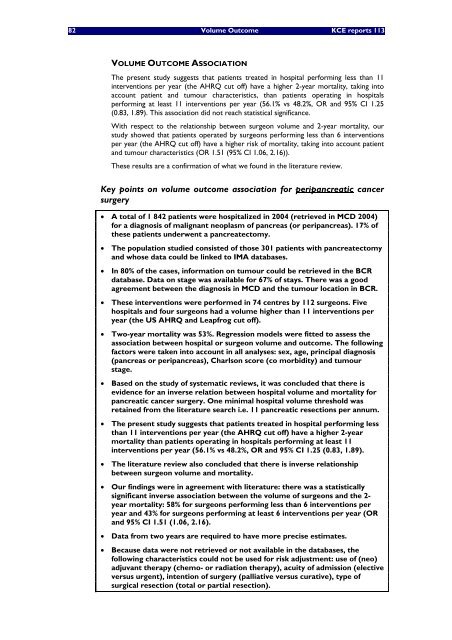Het volume van chirurgische ingrepen en de impact ervan op ... - KCE
Het volume van chirurgische ingrepen en de impact ervan op ... - KCE
Het volume van chirurgische ingrepen en de impact ervan op ... - KCE
Create successful ePaper yourself
Turn your PDF publications into a flip-book with our unique Google optimized e-Paper software.
82 Volume Outcome <strong>KCE</strong> reports 113<br />
VOLUME OUTCOME ASSOCIATION<br />
The pres<strong>en</strong>t study suggests that pati<strong>en</strong>ts treated in hospital performing less than 11<br />
interv<strong>en</strong>tions per year (the AHRQ cut off) have a higher 2-year mortality, taking into<br />
account pati<strong>en</strong>t and tumour characteristics, than pati<strong>en</strong>ts <strong>op</strong>erating in hospitals<br />
performing at least 11 interv<strong>en</strong>tions per year (56.1% vs 48.2%, OR and 95% CI 1.25<br />
(0.83, 1.89). This association did not reach statistical significance.<br />
With respect to the relationship betwe<strong>en</strong> surgeon <strong>volume</strong> and 2-year mortality, our<br />
study showed that pati<strong>en</strong>ts <strong>op</strong>erated by surgeons performing less than 6 interv<strong>en</strong>tions<br />
per year (the AHRQ cut off) have a higher risk of mortality, taking into account pati<strong>en</strong>t<br />
and tumour characteristics (OR 1.51 (95% CI 1.06, 2.16)).<br />
These results are a confirmation of what we found in the literature review.<br />
Key points on <strong>volume</strong> outcome association for peripancreatic cancer<br />
surgery<br />
• A total of 1 842 pati<strong>en</strong>ts were hospitalized in 2004 (retrieved in MCD 2004)<br />
for a diagnosis of malignant ne<strong>op</strong>lasm of pancreas (or peripancreas). 17% of<br />
these pati<strong>en</strong>ts un<strong>de</strong>rw<strong>en</strong>t a pancreatectomy.<br />
• The p<strong>op</strong>ulation studied consisted of those 301 pati<strong>en</strong>ts with pancreatectomy<br />
and whose data could be linked to IMA databases.<br />
• In 80% of the cases, information on tumour could be retrieved in the BCR<br />
database. Data on stage was available for 67% of stays. There was a good<br />
agreem<strong>en</strong>t betwe<strong>en</strong> the diagnosis in MCD and the tumour location in BCR.<br />
• These interv<strong>en</strong>tions were performed in 74 c<strong>en</strong>tres by 112 surgeons. Five<br />
hospitals and four surgeons had a <strong>volume</strong> higher than 11 interv<strong>en</strong>tions per<br />
year (the US AHRQ and Leapfrog cut off).<br />
• Two-year mortality was 53%. Regression mo<strong>de</strong>ls were fitted to assess the<br />
association betwe<strong>en</strong> hospital or surgeon <strong>volume</strong> and outcome. The following<br />
factors were tak<strong>en</strong> into account in all analyses: sex, age, principal diagnosis<br />
(pancreas or peripancreas), Charlson score (co morbidity) and tumour<br />
stage.<br />
• Based on the study of systematic reviews, it was conclu<strong>de</strong>d that there is<br />
evid<strong>en</strong>ce for an inverse relation betwe<strong>en</strong> hospital <strong>volume</strong> and mortality for<br />
pancreatic cancer surgery. One minimal hospital <strong>volume</strong> threshold was<br />
retained from the literature search i.e. 11 pancreatic resections per annum.<br />
• The pres<strong>en</strong>t study suggests that pati<strong>en</strong>ts treated in hospital performing less<br />
than 11 interv<strong>en</strong>tions per year (the AHRQ cut off) have a higher 2-year<br />
mortality than pati<strong>en</strong>ts <strong>op</strong>erating in hospitals performing at least 11<br />
interv<strong>en</strong>tions per year (56.1% vs 48.2%, OR and 95% CI 1.25 (0.83, 1.89).<br />
• The literature review also conclu<strong>de</strong>d that there is inverse relationship<br />
betwe<strong>en</strong> surgeon <strong>volume</strong> and mortality.<br />
• Our findings were in agreem<strong>en</strong>t with literature: there was a statistically<br />
significant inverse association betwe<strong>en</strong> the <strong>volume</strong> of surgeons and the 2year<br />
mortality: 58% for surgeons performing less than 6 interv<strong>en</strong>tions per<br />
year and 43% for surgeons performing at least 6 interv<strong>en</strong>tions per year (OR<br />
and 95% CI 1.51 (1.06, 2.16).<br />
• Data from two years are required to have more precise estimates.<br />
• Because data were not retrieved or not available in the databases, the<br />
following characteristics could not be used for risk adjustm<strong>en</strong>t: use of (neo)<br />
adju<strong>van</strong>t therapy (chemo- or radiation therapy), acuity of admission (elective<br />
versus urg<strong>en</strong>t), int<strong>en</strong>tion of surgery (palliative versus curative), type of<br />
surgical resection (total or partial resection).

















